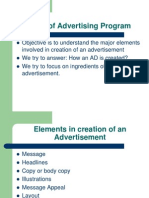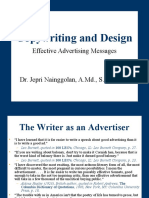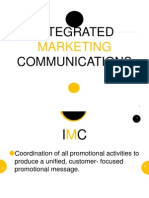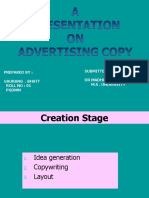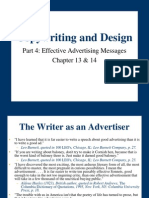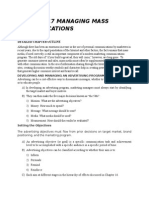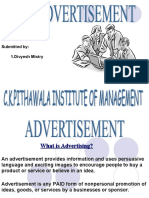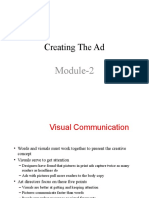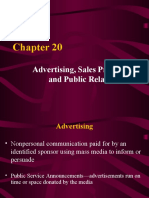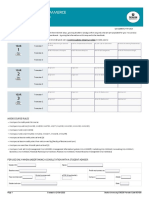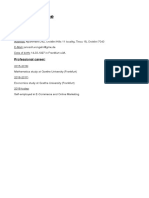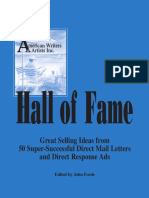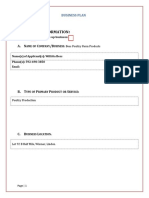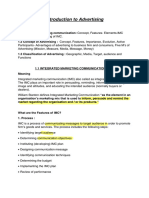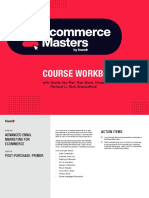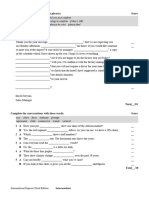2025-01-10
Advertisement Development
1
� 2025-01-10
2
� 2025-01-10
3
� 2025-01-10
Advertising
• Anything that turns the attention to an article or a service or an idea
• Power-packed process pertaining to the dissemination of information
concerning an idea, service or a product to compel an action in line with the
intension of an advertiser
• Tantalizing technique of popularizing a product
• According to American Marketing Association, “Advertising is any paid form
of non-personal presentation of ideas, goods or services by an identified
sponsor.”
4
� 2025-01-10
Advertising
Attributes of Advertising Components of
advertising industry
• Mass-communication
• Informative • Advertisers
• A persuasive act • Media-owners
• A competitive act
• Advertising Agencies
• Not the part of product
• Paid-for • Consumers
• Has Identified Sponsor • Governments
• Non-personal Presentation
Print Advertising
• Advertisement Printed
on paper medium
• Newspapers,
magazines,
newsletters, booklets,
flyers, direct mail, or
anything else that
would be considered a
printed medium
• In 17th century in
England, several different
forms of advertisements
appeared in newspapers
and on handbills
10
5
� 2025-01-10
Print Advertising
• Modern print advertising
• In 1836, when a
French newspaper
called La Presse
charged for
advertisements and
lowered the price of
the newspaper
• This is the birth of
commercial press
11
Characteristics of Print Advertising
• Permanent
• Re-read or clipped out for reference
• Discarded after reading but still repeatedly used by various other people
• Magazines tend to be kept for longer periods
• Easier Segmentation and Targeting
• Magazines - variety of subjects and approaches
• Strong segmentation and targeting
• Contact people with a specific interest in the product category
• Physical proof
• Availability of physical or written proof on sales, circulation and readership
• Media planning becomes easier
12
6
� 2025-01-10
Characteristics of Print Advertising
• Measurable results
• Results of the advertisements can often be assessed easily
• Coupon returns , especially coded coupons
• Cheaper and easily accessible to readers
• Print media can be and frequently are read on trains, buses or airplanes
• Whereas only rarely would someone carry a radio or TV on public
transport
• Portable and independent and also cheap
• The medium tends to have the full attention of the readers.
• People have habit for reading some form of print media.
13
Print Advertising
Newspaper
Advertising
• Considered by
many as the
advertising
mainstay
• Approximately 85-
90 percent of the
population read a
newspaper
• Very effective
14
7
� 2025-01-10
15
Print Advertising
Magazine Advertising
• Reaches a specific
audience
• Let advertisers get
creative with their ads
by using graphics and
color
• Informative ads can be
very persuasive. It's
important to determine
which magazine best
suits your needs.
16
8
� 2025-01-10
Outdoor Billboards & Posters
• Outdoor advertising usually
comes in two forms
• Giant billboards seen in
roadways,
• Transit posters like the ones
in subways and on buses.
• Print media ads in
brochures, print catalogs,
flyers, posters are also
categories of print
advertising.
17
Print Advertising
Phone Books
• A yellow page ad
• Unlike other forms of advertising, the ad remains the same for at least a year.
Direct Mail
• Earlier it used to be a printed form of advertising but not necessarily any
more after the invent of Mails and Brochures
18
9
� 2025-01-10
Print Advertising
Advantages Disadvantages
• Cheap
• Ads can be inserted quickly
• Short Life
• Response by coupon is possible • Poor Print Quality
• Demographic and Geo- • Passive Medium
demographic Selectivity
• The Press can always accept more • Static Medium
adverts
• Poor Literacy Level
• Products are often grouped
together • Clutter
19
Copywriting
• Copywriting is art of writing selling message
• Matter written in words is called copy
• Ad copy is the written (print ads) and spoken
(broadcast) parts of advertisement
• Other matters in the advertisement
• photographs, illustrations, logos, pictures, etc.
• Copywriting – Process where Copywriters write the
verbal message
20
10
� 2025-01-10
Copywriting
• A copywriter should combine both worlds of
linguistic ability and business sense
• KEY CONSIDERATION:
• What am I Advertising?
• To whom am I advertising?
• How can I convey best advertising message to
my readers?
• Where and how the product is being sold?
• When is the product purchased and used?
• What legal implications are involved?
21
Components of Ad Copy
22
11
� 2025-01-10
Components of Ad Copy
1. Headline
• Appears at the top of the whole advertisement layout
• Larger and bolder compared to other content
• Headlines are supported by sub-heads or subsidiary
headlines
• Acts as a catchy line which generally can be related to
advertisement appeals in the form of text
• Can be short or long is the most important element of
the copy as it grab the attention of the reader
• Headline should be:
• Unique
• Concise
• Crisp
• Provocative
23
Types of Headlines
• News headlines: Provides news about anything like a new product, lower prices, etc.
• Benefit headlines: Key customer benefit offered is stated
• Emotional headlines: carry emotional appeals
• Curiosity headlines: uses humor, mystery, etc
• Directive headlines: provoke a customer to take action and are highly suggestive
• Slogan headlines: reproduce the company’s slogan like tagline or even logos
• Horn-blowing headlines: make claims about the company’s achievements
• Headline can be based on different themes: Declarative, Interrogative, commanding,
challenging, testimonials, News, Emotional, Bargain, Announcement etc.
24
12
� 2025-01-10
25
2. Sub-Headings
• Sub-Heading are presented in
smaller size font than the headline
• Sub-heading maintain a sense of
movement in the advertisement
and also divide the ad into sections
• It makes the ad interesting to read
and also further endorse the
headline
• Sub-heading are also used to
emphasize the unique selling
propositions (USPs)
26
13
� 2025-01-10
3. Body Copy
• The main body of the ad apart from visual elements, headlines and captions
• Some ads may have a few words but some may have lengthy descriptive body copy
• Generally simple products like convenience goods, have little copy but technical products
and new products might have a wordy copy
• The worded description in body copy known as body text and visual part as illustration
• Body Text
• It provides justifications to the headline and explains product/service features being
advertised
• Body Text can be written in different formats: Emotive, Hard selling, Informative,
Narrative, Prestige, Picture
27
Body Copy
• Illustration
• It is pictorial presentation of the product or its users in the ad copy in the form of
drawing or actual pictures
• An illustration catches the viewer’s attention, creates desires to own the product an
makes the print ad more interesting; illustrations in print ads become very persuasive in
recent days
• Illustrations must have attributes like: Simple, Interesting, Suggestive, Relevant
• Illustrations in print ad can be presented using various techniques:
• Comparison
• Contrast
• Dramatization
• Product Portrayal
• Symbolic
28
14
� 2025-01-10
Body Copy
• Narrative copy: Uses story
• Straight-line copy: Starts from where
the headline has left off
• Dialog copy: Has a conversation
between characters
• Monologue copy: Carries what one
character says
• Picture and action copy: Relies on
visuals to narrate the story
• Cross-Leads copy is generally bold
and bigger to make it easily
readable
29
4. Slogan
• A catchy sentence or phrase which is easy to remember
• Copywriters continuously repeat slogan to establish its persistency for a
campaign
• Creates an impact by repetition
• It gives an identity to the company or its products and services
• A concise but effective way of telling an idea.
• Slogans may replace headlines or vice-versa.
• Slogans may use an appeal, or a pleasant incident in the life or a product, a
pleasant description of a product quality
• For e.g.: Coke~ Chiso Bhanekai Coca Cola, Nike ~ Just Do it, KFC ~ Finger
Lickin' Good
30
15
� 2025-01-10
5. Signatures: Logos, Symbols and Address
• Logos and symbols provide visual identity to the company
• There are various types of logos ranging from trademarks to entirely abstract
logos
• Wordmarks: Coca-Cola, 7Up, Sprite
• Abstract logo or symbol: Mercedes automobiles, McDonald, Nike’s Swoosh
• Some logos are found to be located between the word-mark and abstract
symbols like Apple Computers
• The end part of the ad copy presents the name and address of the sponsor of
the advertisement
31
Objectives of Advertisement Copy
• The major objective of an ad copy is to effectively transfer the message to the target
audience and achieve the desired goal of the advertisement
• The advertisement copy should be fully goal oriented
• There are some key consideration in copywriting which are vital in effectiveness of Ad
Copy:
• Product
• Target Audience
• Message Strategy
• Media
• Law and Norms
• Ad copy Objectives:
• Direct Action Objectives
• Indirect Action Objectives
32
16
� 2025-01-10
Objectives of Advertisement Copy
• Direct Action Objectives
• Direct objective of a copy is to seek direct response in terms of product
enquiry and purchase
• Retail Ad, Consumer promotion, direct response ad are targeted at direct
action on the part of consumers
• Indirect Action Objectives
• Targeted to create hierarchical actions on the consumers (e.g.: AIDCA)
• Such ad copy build brand awareness initially by drawing people’s attention
and successively move towards creating interest, desire, conviction and
purchase
• Attention ~ Drag attention of audience
• Interest ~ Through body copy or core message of ad
• Desire ~ Picture, Color, Product demonstration
• Conviction ~ Benefits and product attributes display (reason to buy)
• Action ~ Action via the likeliness of product with the signatures provides
information for purchase initiatives
33
Requisites of Good Advertising Copy
• Copywriting is more of a creative art than science
• A creative copywriter is able to develop innovative ideas and create unique copies
• Personal
• Ad copy should address the audience personally; every audience who looks or hear the
message should feel that the advertising is addressing him/her, focusing on his/her problems
and trying to solve those problems
• Simplicity
• Ad copy should be written in a simple way so that everyone can read and understand the
content of the copy
• Selection of words, language and presentation should be based on the principle of simplicity;
common spoken language
• Clarity
• Ad copy should effectively communicate the intended message to the targeted audience
• Headline, subhead lines, and body text should preset the sales message clearly; features and
benefits of product
34
17
� 2025-01-10
Requisites of Good Advertising Copy
• Brevity
• Ad copy should be short and crisp with appropriate words, phrases and sentences to
deliver the message
• Brief & effective copy is always desired by the advertiser due to media cost
• Audience Focus
• The ad copy should consider what is important to the target audience
• Message has to be vary to different audience; female audience (Security, beauty,
uniqueness) vs message to male audience (Social Status, freedom)
• Uniqueness
• Ad copy should not be the ‘run-of-the-mill’ type or kind of copycats from
competitor’s advertisement
• The ads copy should be unique from audience point of view and marketers point of
view
35
Requisites of Good Advertising Copy
• Interesting
• Ads copy should be interesting in order to beat the clutter in the ad channel
• The chance of even noticing an ad become very low if it is not presented interestingly
• Use of clinches, punctuations, alliterations, colors and white spaces makes the ad copy
interesting
• Honesty
• Consumers movements and subsequent legislations have made deceptive
advertisements illegal and immoral in many countries
• Audience expect truthfulness in ads; copywriters should describe the features and
benefits in the most appropriate ways
• Flow of Ideas
• Ad copy should present a continuous flow of ideas from the headline through the body
text to the strapline
• All elements of the copy should be focused on a central theme
36
18
� 2025-01-10
Types of Advertisement Copy
• Scientific Copy
• It provides the technical
specifications of product;
product attributes and benefits
with clear description of scientific
terms
• For e.g.: Ad of Computers,
Home appliances, Electronic
Equipment
37
Types of
Advertisement Copy
• Descriptive Copy
• It describes product
attributes and benefits in
non-technical language
• It highlights the features
that are important in
everyday life for
consumers
38
19
� 2025-01-10
Types of Advertisement Copy
• Narrative Copy
• It is built around a fictional story that tells a
story as how a person faced a problem and
how the use of product solved the problem
(Slice of Life)
39
Types of Advertisement Copy
• Humorous Copy
• It use humor to communicate the message; as humor is one of the most interesting
way to communicate a message
• Such ad copy are used across a variety of consumers products
•
40
20
� 2025-01-10
Types of Advertisement Copy
• Colloquial Copy
• It use common man’s dialogues to convey
the advertising message
• Such ad copy use at least two people
shown as talking or singing to each other
• Topical Copy
• Such copy describes the product in
relation to some events : Sport Event
Political Event, cultural event
41
Types of Advertisement Copy
• Endorsement Copy
• In Endorsement copy, product or service are endorsed with some popular celebrity such as
film star, sports persons, doctors, engineers etc.
• Celebrities are used in ad in four ways: testimonials, product endorsement, as actor and as
spokesperson
• The credibility of celebrity as an expert in the product or service is more important in
advertising than celebrity’s fame
42
21
� 2025-01-10
Types of
Advertisement Copy
Questioning Copy
• The questioning copy
forwards several
questions to the viewers
without providing any
answers to the questions
• The questions are
focused on several
aspects of the product
features and benefits
43
Types of
Advertisement Copy
Prestige Copy
• The prestige copy uses few
words and creates the
prestige image of the product
through pictures and
atmospherics
• For e.g.: Ad copy of Jewellery,
Perfumes, Expensive products
44
22
� 2025-01-10
Types of
Advertisement Copy
Explanatory Copy
• It provides several
reasons for the
purchase of product
• Each features of the
product presented with
an associated
benefit
45
Types of Advertisement Copy
• Wordless Copy
• It uses pictures of the advertised brand with the company name and logo
• Most display ad try to communicate with pictures rather than words
46
23
� 2025-01-10
Types of Advertisement Copy
Musical Copy
• It is mostly used in radio and Television advertising based on different musical
themes: some based on song others on popular tunes
• The message is converted into songs format (parody) and are presented along a
popular or folk tune
Institutional Copy
• It is not to sell products and service
• Its targeted towards building the image
of the advertiser by highlighting on
technical superiority, research, marketing
networks, awards received, CSR etc.
47
Types of Advertisement Copy
Human Interest Copy
• It aims to influence audiences emotions and feelings rather their rationality
and logic
• The selling points are delivered in terms of human emotions: passion, love,
fear, humor, curiosity,
envy etc.
48
24
� 2025-01-10
Layout Design
49
Ma1
Layout Design
• Elements - headline, body copy, illustrations, photographs, logos, coupons,
signature and so on.
• Design has to consider line, colors, texture, shapes, direction, size and space to
make it look better.
• Similarly layout design principles are balance, proportion, sequence, unity and
emphasis
• Balance: Balancing various elements of the print ad
• Proportion Group: Grouping the relationship between the sizes of objects. It
means no part is too large or too small. In print ad 2/3 of space is occupied by
visuals.
50
25
�Slide 50
Ma1 https://www.lifewire.com/ad-layout-and-design-strategies-1077222
Microsoft account, 2023-12-30
� 2025-01-10
Layout Design
• Sequence: The order in which ad elements are seen. Generally sequence is
dictated by space and the eye movement. Eye movement follows a track from
left to right but not always like in the case of Urdu, Persian and Arabic.
• Unity: A cohesive whole where nothing should be out of place. Each element
must belong to the advertisement. One unrelated element and the whole ad
tastes sour.
• Emphasis: What is to be emphasized? A word, a picture, an illustration, a
contour of a car or a fog light, a company logo or just a slogan.
51
26













